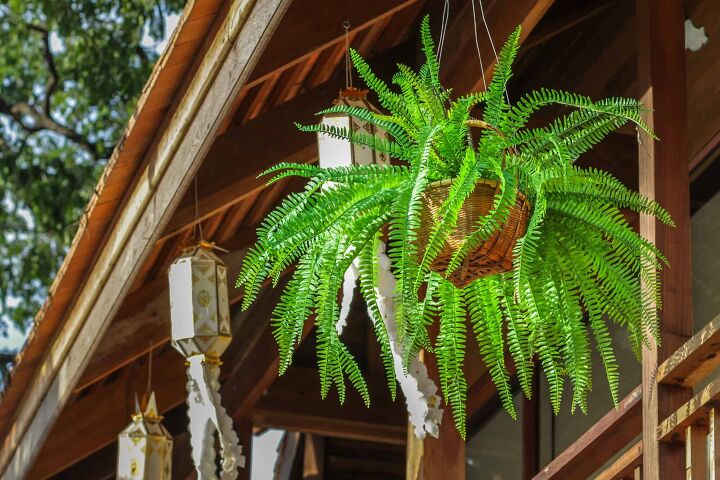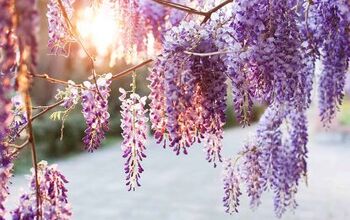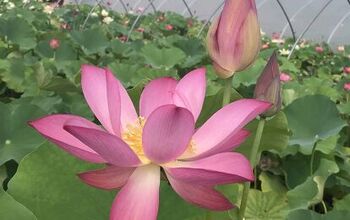Different Types of Fern Plants (with Photos)

Ferns are considered some of the oldest living plants on the earth and they can be grown outdoors in your garden or indoors as houseplants. They are a leafy type of plant with leaves (fronds) that drape, adding beauty and a touch of drama to any setting. Most indoor varieties are relatively simple to grow and care for. When planted outdoors, ferns are an excellent choice for ground cover in the proper conditions.
Whether you choose fern plants to add a finishing touch to a terrarium, help clean up your indoor air, or add depth and deep green accents to your garden, there are many varieties available. Some of the most common types of indoor fern plants include the Boston Fern, Holly Fern, Staghorn Ferns, and Royal Ferns. Whereas, some of the most common types of outdoor fern plants are the Ostrich Fern, Australian Tree Fern, Japanese Painted Fern, Cinnamon Fern, and Bird’s Nest Fern.
Continue reading for our comprehensive guide on the various types of fern plants, including how to identify and care for them. We’ll help you understand exactly which varieties thrive outside and which are best grown indoors. That way, you can make an informed decision on which type of fern plant is best for your growing purposes.
Do You Need Landscaping Services?
Get free, zero-commitment quotes from pro contractors near you.

Fern Basics
Dating back to over 350 million years ago, ferns are among the most ancient plants on earth. Most of the original ferns are no longer around today, though, they did begin evolving around 70 million years ago. Ferns are a type of vascular plant, belonging to the Polypodiopsida class of plants. The term ‘vascular’ indicates the connective tissue that lets a plant transfer food and water throughout its various systems. Vascular plant evolution allowed plants to survive out of water.
Based on some estimates, there are over 20,000 known fern species that grow around the world. Unlike many other varieties of plants, ferns do not produce flowers. Instead, most fronds that are comprised of blade-like leaves, or pinnae, connect to a stem. Many types of fern plants can thrive both as houseplants and outdoors. Though, some are best suited for one particular environment.
Outdoor ferns grow best when placed in partial shade, while those grown indoors thrive best in bright light, but not direct sunlight. Indoor varieties tend to reach about one to two feet tall, and the tallest outdoor ferns can reach up to 82 feet tall. Ferns are an excellent choice for the beginner gardener, as they are easy to grow and rarely suffer from insect infestations or disease.
Indoor Fern Plants
Generally speaking, indoor ferns are hardy, low-maintenance types of plants. Though, there are some guidelines you should follow to have the best results with these leafy green plants. Make sure to choose a spacious area in your home, as they tend to sprout long fronds in all directions.
Indoor ferns are well suited for hanging from ceiling hooks in secluded corners of rooms that get the maximum amount of light. Though, these areas should rarely, if ever, receive direct sunlight.
Since ferns originate in dense tropical shady environments, it’s important that you mimic these woodlands in your own home. This means that fern houseplants grow best inside when they have plenty of shade and are kept away from windows with direct sunlight. Rooms with indoor ferns should be kept at a comfortable 70 degrees Fahrenheit. These plants also need sufficient humidity and you’ll want to mist it daily for best results.
To help retain moisture, keep your fern in a plastic pot rather than repotting them in a clay pot. Also, your fern plant will thrive and survive indoors if you prune damaged leaves, remove pests immediately, and fertilize the plant during the growing season. With that said, let’s take a look at some of the most popular indoor fern plant varieties.
1. Boston Fern
Boston Ferns (Nephrolepis exaltata) are considered one of the most popular indoor ferns, commonly seen hanging on front porches in late spring to early fall. Often referred to as the Sword fern, the Boston fern is an evergreen perennial plant. Although it’s not difficult to grow these ferns, they do require special care to prevent the fronds from dying off.
These types of ferns grow between 16 inches and 35 inches tall, with long trailing leaves that look lovely in hanging baskets. The leaves are dark green, with many deep, evenly spaced-out indentations on the edges. For best results, it’s important that Boston ferns have consistently high humidity levels. This means that if you live in dry conditions or during the winter months, you’ll want to keep the soil damp in mist the plant daily.
The Boston fern also prefers indirect sunlight rather than complete shade and should be kept out of direct sunlight at all costs. Although Boston ferns can be grown outdoors, they need sufficient moisture and must be placed in full shade. In fact, these types of ferns grown wild outdoors in many regions around the world.
2. Staghorn Fern
The Staghorn Fern (genus Platycerium) are native to tropical and temperate climates and are one of the most strange-looking fern plants. There are roughly 18 different species of Staghorn ferns, many of which resemble elk or stag horns – hence the name. Although Staghorn Ferns typically grow on the bark of trees in Australia, Africa, and Asia, they make great houseplants if they have proper drainage and are planted in coarse soil.
This type of fern has two sets of fronds, which are green, fertile, antler-shaped, and hang out from the rhizome. Whereas, the brown, infertile fronds grow outside of the green ones and are flat, short, and round-shaped. When compared to other varieties, Staghorn Ferns differ because they are long and wide. They have spores on the underside of their fronds and can grow up to four feet in length.
When grown as a houseplant, you can imitate the way they grow in nature. Staghorn ferns can be connected to board mounts and to water them you’ll need to submerge the whole board in water. Then, leave it to dry out before repeating the whole process. Though, you can successfully grow these types of ferns indoors, in a pot. As with most other fern plant varieties, Staghorn ferns require damp soil to thrive. But, too much dampness and you’ll rot the fern’s leaves.
3. Royal Fern
Royal Ferns (Osmunda regalis) is another type of fern plant that is relatively easy to grow indoors. It is one of the largest European deciduous ferns, with fronds that can grow between 24 and 63 inches long and reach up to 16 inches wide. The number of leaflets on the stem can be as many as 13 pairs and the leaves can reach up to 2.5 inches long. Their large fern leaves are what gives this type of fern that “royal” look.
Though they are ideal for indoor growing, royal ferns can also be planted outdoors. Since they are resistant to rabbits and deer, Royal ferns can make a great addition to your garden without worrying about animals munching on the leaves. Though, you’ll want to make sure that you have plenty of room for the plant to reach its full size – a three-foot spread and approximately six feet tall.
As with most other types of ferns, Royal ferns are best grown in shady areas. They enjoy damp, acidic soil and due to its size, you’ll need a large container and plenty of space if grown indoors. In the wild, it’s common to see Royal ferns growing near rivers and bogs in shady woodland areas.
4. Maidenhair Fern
The Maidenhair Fern (genus Adiantum) is one of the most delicate varieties of indoor ferns. This unique-looking plant has blacks stems and small, petite leaves. Some variations of Maidenhair ferns have small, almost oval-shaped leaflets (pinnae), while others have longer leaflets that are more common with fern plants. Regardless, it is attractive as a houseplant, but can be challenging to grow.
Maidenhair ferns grow best in areas with high humidity but their leaves cannot tolerate misting. They will grow well in the corner of a large bathroom due to the humidity, but it should not be placed in direct sunlight. These ferns look great in hanging baskets because of their long leaves and trailing characteristics. If growing indoors, place them in a small container or pot.
If possible, you should avoid repotting Maidenhair ferns as this often causes them to die. When grown as a houseplant, make sure that you keep them far away from direct sunlight and drafts.
5. Rabbit’s Foot Fern
Rabbit’s Foot Ferns (Davallia fenjeensis) is another easy-to-care-for type of fern plant. It has a wiry-looking appearance, but makes an excellent houseplant and can be quite resilient when grown indoors. Most place these types of ferns in shallow hanging containers, as they trail naturally and their rhizomes grow long, extending away from the pot.
The leaves of the Rabbit’s Foot fern grow in a triangular pattern, giving the plant an untamed, bushy look. One of the identifying characteristics of this type of fern is the furry trailing rhizomes, which gave the plant its name. When viewed up close, the rhizomes look similar to rabbit’s feet and are one of the most unique and appealing features of this fern houseplant.
However, it’s important that the rhizomes do not get buried in soil as they will start rotting. While Rabbit’s Foot ferns are considered one of the easiest ferns to grown, they still require high humidity levels. Therefore, be sure to mist your fern daily to encourage healthy plant growth.
6. Lemon Button Fern
Native to Australia and Asia, Lemon Button ferns (Nephrolepis cordifolia) are a wonderful type of fern to grow inside. They are a smaller version of the Boston fern and love shady locations in the home, away from direct sunlight. One of the distinguishing characteristics of these types of ferns is their long fern leaves. Their leaves are almost sword-like with small leaflets, which explains why this plant is often referred to as the ‘Sword fern,’ Narrow Sword fern,’ or the ‘Ladder fern.’
Ideal locations for growing Lemon Button ferns include on sideboards, countertops, and tables throughout the home. Unlike most other ferns, the long straight leaves of ‘lemon buttons’ grown upward. As with most indoor varieties, these ferns must be positioned away from direct sunlight and need to be kept moist with high humidity.
Lemon Button ferns tend to be small indoor ferns, only growing just under 12 inches tall. If you want to grow this type of fern outdoors, a small rock garden in the shade can be the ideal location.
7. Blue Star Fern
For an indoor fern variety that is easy to grow and recommended for beginners, choose the Blue Star fern (Phlebodium aureum). Both its unique appearance and ease of care make this type of fern a popular choice for both novice and experienced plant parents alike. Blue Star ferns are a tropical variety that grow well indoors with frequent misting.
The fern’s blue-green leaves are relatively similar to those found on Staghorn ferns. Though, unlike Staghorn ferns, the Blue Star fern has leaves that grow at the end of elongated fronds. One of the main reasons why this type of fern is so popular has to do with its relatively squat nature. When grown in containers, the plant will rarely grow higher than twelve inches and has a medium-sized spread.
Ideal care of this type of houseplant includes ensuring that the soil is consistently moist, but not overly damp. If the soil does become too damp, you risk root rot and could kill your Blue Star fern.
8. Cretan Brake Fern
Sometimes referred to as a ‘ribbon fern,’ the Cretan Brake fern (Pteris cretica) is one of the most visually appealing types of indoor ferns. This bushy variety consists of elongated sword-like leaves, which display two distinct shades of green. If you’re looking for a fern that is easy to care for, add the Cretan Brake fern to your list!
Cretan Brake ferns have uniquely shaped leaves that are not typical of other types of ferns. They grow on the ends of long fronds and look similar to palm leaves. Each individual leaf has a pale green stripe that runs down the middle, with dark green on the edges. This type of fern is considered a medium to larger variety of fern houseplant. Under the proper conditions, the Cretan Brake fern can grow up to 2.5 feet tall and have a 2-foot spread.
If desired, this fern can also be grown outdoors. However, since it is a tropical type of fern, it must be grown in a warm climate. Also, for best results, make sure to place Cretan Brake ferns in a shady part of your garden.
9. Holly Fern
The Holly fern (Crytomium falcatum) makes an excellent houseplant. It is a perennial fern species that belongs to the Dryopteridaceae family. The leaves on a Holly fern grow to approximately 1.6 feet in length, each consisting of about 10 leaflets on both sides of the stem. They are dark green and glossy, resembling the leaves found on holly bushes – hence the name.
Although Holly ferns are commonly grown outdoors, many find them incredibly easy to grow inside. According to many fern enthusiasts, Holly ferns are among the easiest varieties to grow indoors. They are light, heat, and water tolerant. Whether you choose to grow them indoors or outdoors, these types of ferns require sufficient shade.
Holly ferns are available in three distinct species including East Indian, Hawaiian, and Japanese Holly ferns.
Outdoor Fern Plants
Depending on the particular climate in your area, there are many types of fern plants that can be grown in your garden. If you’re looking to add a sense of drama to the landscape design of your flower garden, backyard, or outdoor living spaces, you can never go wrong with planting ferns. While some evergreen ferns can offer stunning greenery throughout the winter months, the trailing nature of many other varieties of outdoor ferns work great for ground covers.
Of course, many of the aforementioned fern plants can be grown outdoors, in addition to indoors, with the proper care. Although you may find ferns growing wild around your property, transplanting them to your garden or even picking up a new one from a local retailer can cause the plant to die. Therefore, it is crucial that you know to care for ferns to increase their chances of surviving and thriving outdoors.
The first step is choosing the right fern that will fit your space. Particularly, you want to choose a fern that is ideal for your growing conditions. This will give you a head start and allow the plant to survive as long as possible. When grown outdoors, ferns should be mulched regularly and watered during dry periods. Also, in the spring, you should divide your ferns that have gotten too large to prevent them from engulfing your whole garden.
With that said, let’s examine some of the most common varieties of outdoor fern plants that you can choose from to add beauty and life to your garden.
1. Ostrich Fern
The Ostrich Fern (genus Matteuccia) is one of the tallest and most majestic varieties of outdoor ferns. These ferns are so tall that their fronds often reach up to five feet in length. Ostrich fern leaves grow in an upward direction, resembling a vase. This is a clumping type of fern, with leaves that are broader and the top and gradually taper off towards the base. At the widest spot, the fronds can be up to 14 inches wide.
These types of ferns get their name from the fact that the leaves look similar to an ostrich’s tail. Other common descriptive nicknames for this fern include ‘Fiddlehead fern’ and ‘Shuttlecock fern.’ Ostrich ferns grow best in temperate regions. They thrive in shade, moist soil, and like most ferns, will burn in too much direct sunlight exposure. For best results, these ferns should also be shielded from wind and hail.
To make Ostrich ferns more compact, water them rarely at the ground level. Also, be sure to avoid getting any moisture on their delicate leaves.
2. Japanese Painted Fern
The Japanese Painted fern (Athyrium niponicum) is the perfect choice for those who live in areas that experience harsh winters. This outdoor fern can withstand temperatures as low as -30 degrees Fahrenheit. It is a gorgeous deciduous fern that has a crawling nature and is wonderful for ground cover in shaded spots of your garden.
Japanese Painted fern’s leaflets are characterized by their blue-green or silvery color and are attached to either purple or red stems. Though, there are a wide array of cultivars in this genus that have varying types and colors of leaves. The fronds on this fern only reach lengths of approximately 18 inches.
Aside from their beautiful coloring, Japanese Painted ferns are most desired for their hardiness. Though, like nearly all other varieties of outdoor ferns, these plants require plenty of shade to thrive.
3. Australian Tree Fern
Unlike the other ferns on our list, the Australian Tree Fern is technically a type of tree rather than a bushy garden plant. There are a number of species that fall under this categorization as a ‘tree fern,’ including the ‘Soft Tree fern’ (Dicksonia antarctica), the ‘Lacy Tree fern’ (Sphaeropteris cooperi), and the ‘Rough Tree fern’ (Alsophila australis).
The Australian Tree fern can grow to reach between 15 and 50 feet in height. In many ways, these tree ferns look similar to palm trees with their thick trunks (about six inches around) and large sprouting fronds at the top. Some of these fronds can reach up to 8 feet in length and fan out, creating a canopy that can reach up to 19 feet in diameter.
As you might expect, these fern trees thrive in the rain forests of Australia and New Zealand. Therefore, they should only be planted in areas that have warm temperatures and experience heavy participation. Also, unlike most other types of ferns, these can grow just as well in full, direct sunlight as they do in shade.
4. Asparagus Fern
The Asparagus fern (Asparagus aethiopicus) is one of the most peculiar-looking outdoor fern varieties. It has a fuzzy appearance that is ideal for rock or ornamental gardens or even placed in outdoor hanging baskets. Depending on the particular cultivar, Asparagus fans may have a scrambling nature or be tall growing.
In fact, there are three varieties of this type of fern, with the most common having fine, needle-like leaves. Their small spines can cause irritation of the skin when touched. One of the most attractive features of Asparagus ferns is their small red berries that are sometimes produced. They look lovely against their light lime-green foliage.
Asparagus ferns thrive in bright sunlight and tend to multiply exceptionally well that they end up taking over entire gardens. Therefore, you’ll want to keep these guys in check with regular pruning. Depending on the climate, you might need to bring your Asparagus ferns inside for the winter if they’re in baskets or containers. While you can grow these ferns indoors, they can be challenging to look after.
5. Bird’s Nest Fern
The Bird’s Nest Fern (Asplenium nidus) is a beautiful-looking fern, perfect for ornamental gardens. This fern gets its name from the fact that the center of the fern looks similar to a bird’s nest. They can be found growing in soil and on trees and rocks.
Bird’s Nest ferns have wide leathery fronds that resemble banana leaves and can grow to between 20 and 60 inches long and up to 8 inches wide. In the sun, the fronds on this type of fern will appear crinkled.
Because of its compact nature, the Bird’s Nest Fern is often the ideal choice for rock gardens. Though, you’ll want to ensure that the plant is kept moist and is grown in shade. They offer a great contrast for a garden’s flowering plants. Under the right conditions, Bird’s Nest ferns can also be successfully grown indoors.
6. Cinnamon Fern
The Cinnamon fern (Osmundastrum cinnamomeum) is a common type of outdoor fern. It is one of the larger varieties with broad fronds and long leaflets. The fronds are much wider at the base at taper towards the end, resulting in a triangular shape. These ferns can grow between one and five feet tall, measuring six to eight inches wide.
You’ll often find this type of fern growing wild alongside creeks, streams, and ponds. As a result, Cinnamon ferns require a lot of water to thrive when planted outdoors in a garden. The name comes from the cinnamon-colored spores that form on the fronds. They usually develop in the center of the plant, which gives it a color that shifts from green to light brown.
7. Christmas Fern
The Christmas fern (Polystichum acrostichoides) is a deciduous evergreen plant that is popular in the southeast and looks similar to the Boston fern. It gets its name because some of the plant stays green all year long. The dark green leaves of the Christmas fern can reach up 3 feet long and 4 inches wide.
Christmas ferns thrive in areas that receive partial or full shade, but can tolerate some sunlight. Like most other outdoor ferns, they require moist, well-draining soil that has an abundance of organic matter. Generally speaking, growing these types of ferns requires minimal effort.
8. Autumn Fern
Also referred to as the Japanese Shield fern, the Autumn fern (Dryopteris erythrosora) is a hardy semi-evergreen fern with arching fronds. The foliage is green in the summer, a coppery pink in the spring, and a full copper color in the fall. This fern is known for the year-round visual interest it adds to any shady garden.
Autumn ferns produce no flowers or seeds. It is an ancient woodland plant that grows best in partial or full shade and soil that is well-drained, rich, and slightly acidic. These ferns can withstand short exposure to afternoon sunlight, but won’t do well in prolonged sunlight or harsh heat.
Do You Need Landscaping Services?
Get free, zero-commitment quotes from pro contractors near you.

9. Lady Fern
The Lady fern (Athyrium filix-femina) can be found in forests all over the world. It has fronds that are compound and cut two or three times, which gives them a lace-like appearance. These ferns are drought tolerant, can grow to reach up to three feet tall, and has a stunning upright growth habit.
Due to its naturally wide distribution, Lady ferns can be grown in gardens virtually anywhere. So long as it has enough moisture, the fern can be easy to propagate. Though, this plant will spread fast so make sure you have plenty of space to accommodate and prune it regularly.

Jessica considers herself a home improvement and design enthusiast. She grew up surrounded by constant home improvement projects and owes most of what she knows to helping her dad renovate her childhood home. Being a Los Angeles resident, Jessica spends a lot of her time looking for her next DIY project and sharing her love for home design.
More by Jessica Stone
























![10 Most Dangerous Neighborhoods in Baltimore [Updated]](https://cdn-fastly.upgradedhome.com/media/2023/07/31/9075655/10-most-dangerous-neighborhoods-in-baltimore-updated.jpg?size=350x220)




![12 Washing Machine Brands to Avoid [with Recall Data]](https://cdn-fastly.upgradedhome.com/media/2023/07/31/9075781/12-washing-machine-brands-to-avoid-with-recall-data.jpg?size=350x220)




